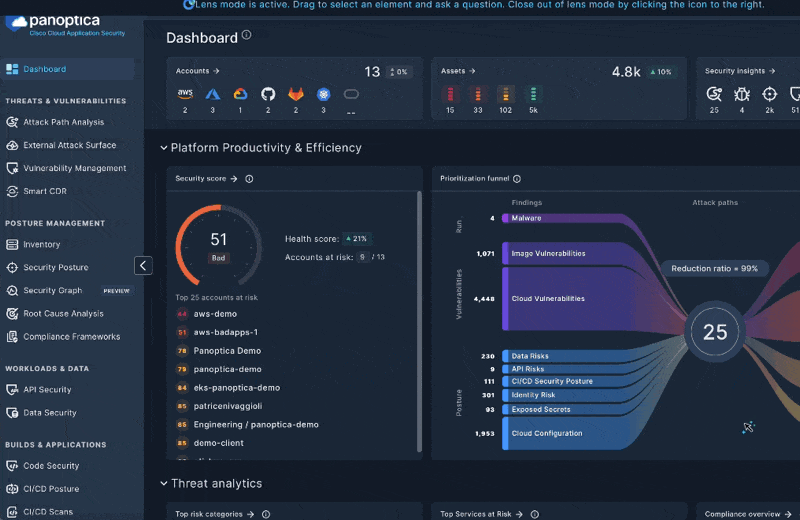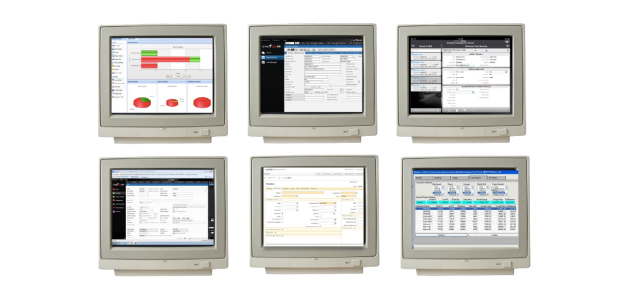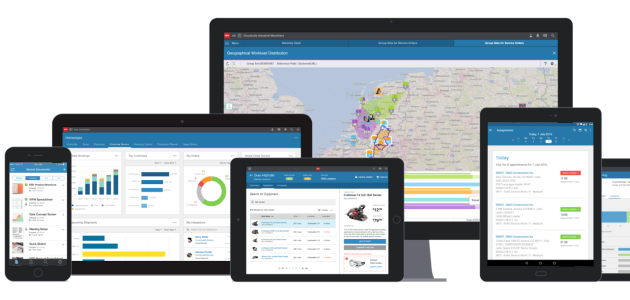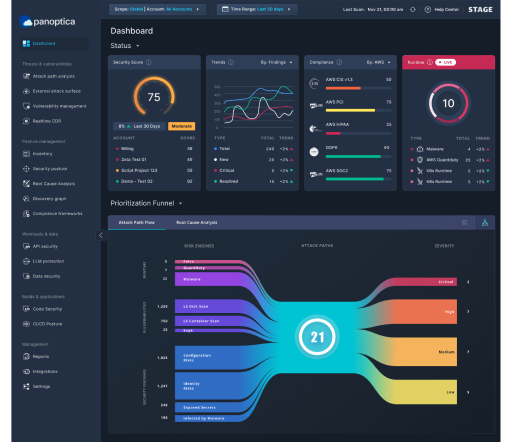Impact
Design for Impact
My focus has always been to drive design's businesses impact through innovative strategies and human-centered design. Discover how I have consistently shown a commitment to leveraging design as a transformative force within organizations to drive growth, efficiency, and sustained value.
How would you like to explore my impact?
Design Leadership & Strategy
Throughout my career, my focus on integrating design with business strategy has consistently delivered impactful revenue growth
Create a Clear Vision with Effective Storytelling
Setting a clear vision and ensuring that it is well-communicated is fundamental.
Example: At Infor, I articulated a clear and compelling vision of creating "beautiful enterprise experiences.” I championed a fresh perspective that ERP software should not just be functional and reliable but also pleasurable and meaningful. This philosophy was foundational in guiding the re-imagination of Infor's product suite. This strategic clarity galvanized the organization, driving significant advancements in user experience and establishing a compelling differentiator in the enterprise software market.
Clear Impact Awareness & Goal Alignment
Ensuring that each team member is aware of their impact on the organization and customer experience is vital.
Example: At Cisco while developing a new AI platform, I used a rigorous evidence-based design methodology that emphasized prototyping and user feedback to validate each phase of design for the team. This process involved clear goal-setting and continuous performance assessments to ensure alignment with user needs and business objectives.
Foster Skill Frameworks & Calibration
Using a well-defined skills framework, I ensure consistency in performance evaluations, including metrics for vision, visual proficiency, interaction, systems thinking, communication, partnership, planning, accountability, effectiveness, outcomes, and grit levels.
Example: At Cisco I implemented a detailed performance calibration approach that included feedback mechanisms from cross-functional teams such as engineers and product managers, and created clearly defined team goals to align with the company’s strategic objectives.
Revenue Growth
Throughout my career, my focus on integrating design with business strategy has consistently delivered impactful revenue growth.
Helped create over $5B in enterprise value at Infor
At Infor, I created and led an agile product experience team of over 120 designers, strategists, and researchers. Our collective efforts pivoted the company to become the third-largest enterprise SaaS provider, creating over $5 billion in enterprise value. We modernized over 40 complex enterprise products, contributing to $800M in SaaS revenue over five years by focusing on usability, user experience, and market-ready design.
Building and scaling TMRW Lab
At TMRW Lab, I developed the TMRW Mapping design process that delivered a 200% increase in new revenue in its first year. This process leveraged design thinking and evidence-based strategies to help mid-market B2B clients unlock transformative value through technology and design.
Driving AI and design consulting revenue at RelationalAI
As VP of Product Design & Strategy at RelationalAI, I launched a go-to-market design strategy for a relational database AI tool, leading to over $3M in consulting revenue within three months. Our human-centered design approach fostered a sustainable annual growth plan of over 14% for AI-driven projects.
Evidence-Based Design
Examples of my evidence-based design approach to accelerate product development and ensure market fit while highlighting the cultural shift within the organization
I have developed an evidence-based design approach that is centered around rigorous validation of hypotheses and continuous user engagement throughout the product development lifecycle. This comprehensive design process, which includes discovery, prototyping, and validation phases, ensures each hypothesis is rigorously tested and iterated upon based on user feedback and data.

Case Study:
Building an Innovation Design Process at Outshift by Cisco
At Outshift, the mission was clear: Shift from a "build first, ask questions later" mentality to a structured, evidence-guided framework. I first helped re-establish design as a cornerstone of product development, integral from the outset and not just a final touch on aesthetics and usability. By promoting early and frequent collaboration between designers, product managers, and developers, we streamlined the design process to focus sharply on delivering key value outcomes.
User Adoption & Conversion
By designing intuitive, value-driven experiences that drive engagement and measurable business outcomes, explore how I help increase user adoption and conversion effectively.
Increased PLG Leads at Outshift by Cisco
At Outshift, I led a redesign of the onboarding process that resulted in a 30% increase in Product-Led Growth (PLG) leads within just 60 days. This redesign focused on streamlining the user journey, making it easier for users to understand and engage with the product, thereby boosting conversion rates and user adoption.
Simplified Product Onboarding at Infor
While at Infor, I worked on simplifying the onboarding processes for over 40 enterprise products. By enhancing usability and user experience, we significantly reduced friction points for new users, fostering a smoother transition and increasing user adoption across the product suite. This holistic approach contributed to the company's considerable growth in SaaS revenue.
Created Evidence-Based Design Process at Outshift by Cisco
Another significant contribution at Outshift was the introduction of an evidence-based design discovery process. This approach enabled us to align product iterations closely with user needs and feedback, which improved overall user experience, reduced churn, and accelerated user adoption for new product launches.
Impact Metrics & Performance
How user-centric design and thorough research impacted customer satisfaction and retention, ultimately reinforcing loyalty and reducing churn.
My approach is centered around measuring outcomes rather than outputs. I prioritize understanding how our designs influence user behaviors and drive key business metrics like adoption, retention, and conversion. Instead of focusing solely on the completion of tasks or features, I emphasize the importance of telemetry and data analysis to gauge the real-world impact of our work.
Case Study:
Building a Skills Framework for a Next-Gen Design Team
Across my entire career I have encouraged my design team members to develop a strong strategic mindset by involving them in the early stages of product development. This includes understanding the broader business objectives, market landscape, and user needs. I have developed a skills framework to help calibrate designers to align with the business' needs. This includes analyzing areas like the designer's strategic and collaboration abilities as well as their impact and effectiveness.
Skills Framework

Customer Satisfaction & Retention
How user-centric design and thorough research impacted customer satisfaction and retention, ultimately reinforcing loyalty and reducing churn.
Enhanced Product Usability Across Infor
At Infor, I led the redesign of over 40 complex enterprise products, focusing on improving usability and user experience. By simplifying interfaces and making tools more intuitive, we significantly reduced user frustration and increased overall user satisfaction. This enhancement played a crucial role in retaining large enterprise clients and reducing churn rates.
Improved Client Experience with TMRWMapping at TMRW Lab
At TMRW Lab, the TMRWMapping design process I developed was instrumental in tailor-fitting solutions to client needs. By engaging in detailed user research and iterative testing, we delivered bespoke solutions that significantly improved customer satisfaction. This personalized approach strengthened client relationships and enhanced our client's end-customer loyalty.
Created a Product Incubation “Garage” at Infor
I launched the first Product Incubation “garage” at Infor, which focused on spotlighting emerging products and services tailored to customer feedback. This initiative not only increased customer visit win rates to over 95% but also significantly boosted customer satisfaction by demonstrating our commitment to continual innovation and responsiveness to their needs.
Human-Centered Design
How thoughtful, innovative design strategies can create distinct market advantages, setting products and companies apart in competitive landscapes.
Empathy & Research:
To deeply understand the user, I prioritize extensive research, including interviews, surveys, ethnographic studies, and usability tests to gather insights into the users' needs, behaviors, pain points, and aspirations. This helps in building empathy and forming a solid foundation for the product’s design process.
Co-Creation Workshops:
Involving users in the design process through co-creation workshops and participatory design sessions is crucial. This not only brings in diverse perspectives but also ensures that solutions are grounded in real user experiences and expectations.
Iterative Design & Prototyping:
HCD is inherently iterative. I advocate for rapid prototyping and iterative testing to validate ideas quickly and refine solutions based on user feedback. This cycle of designing, testing, and refining helps in developing a product that truly resonates with users.
Cross-Functional Collaboration:
Successful HCD relies on collaboration across different functions. I ensure that designers work closely with product managers, engineers, marketers, and other stakeholders to create holistic solutions that meet both user and business needs.
Feedback & Continuous Improvement:
Post-launch, it's essential to continue gathering data on how users interact with the product. Using telemetry and other feedback tools, we can monitor user behavior and make informed decisions about further improvements, ensuring the product evolves in line with user needs.
Market Differentiation
How thoughtful, innovative design strategies can create distinct market advantages, setting products and companies apart in competitive landscapes.
Pioneered Design as a Market Differentiator at Infor
At Infor, I spearheaded the modernization of over 40 enterprise products, transforming them into market-ready solutions with a focus on usability and user experience. This effort not only positioned Infor as the third-largest enterprise SaaS provider but also created a strong differentiation in a crowded market by offering superior user-centric design and enhanced functionality.
Developed Innovative AI Solutions at RelationalAI
As VP of Product Design & Strategy at Relational AI, I led the development and launch of a cutting-edge relational database AI tool. Our human-centered design approach set the product apart from competitors by providing a highly intuitive interface and clear value propositions. This differentiation was crucial in capturing market interest and driving over $3 million in consulting revenue shortly after launch.
Transformative Redesigns at Outshift by Cisco
Through strategic redesigns of our onboarding process at Outshift, we achieved a 30% increase in Product-Led Growth (PLG) leads within 60 days. Our focus on user experience and seamless onboarding differentiated our product in a competitive market, making it easier for users to adopt and engage with our solutions.
Innovation & Incubation
These experiences highlight my commitment to driving operational efficiency and agility, ensuring that processes and products are optimized for peak performance and rapid market responsiveness.
Leading innovation and new product design processes
-
Early Involvement and Cross-Functional Collaboration:
- Engaging design early in the development process to unify the vision and reduce misalignment across teams.Conducting workshops and brainstorming sessions.
-
Evidence-Based Decision Making:
- Shifting from opinion-driven to data-driven decisions by rigorously testing and validating hypotheses through prototyping and user feedback.
-
Design Thinking and Agile Methodologies:
- Applying Design Thinking principles to foster creativity and problem-solving through agile practices to keep the development process flexible and adaptable.
Case Study:
Inventing a patent-pending context aware AI Interface at Outshift by Cisco

At Outshift I personally created a groundbreaking AI initiative designed to optimize user workflows and task management within the enterprise called “Lens.” Key features included context-aware collaboration with a "Context Button" for querying UI objects, multi-item selection for coherent analysis, and interactive UI enhancements like the "Intuitive Contextual Screenshot Region Picker" and "Precision Data Spotlight."
Operational Efficiency & Agility
These experiences highlight my commitment to driving operational efficiency and agility, ensuring that processes and products are optimized for peak performance and rapid market responsiveness.
Transformed the Process for Cloud Security Integration at Outshift by Cisco
I led the integration of a key acquisition into our cloud security product in just five months. This transformation took two separate solutions and turned them into a cohesive CNAPP product, greatly reducing complexity and streamlining time to value. Additionally, I improved our onboarding and funnel strategies, which boosted our Product-Led Growth (PLG) leads by 30% within just 60 days.
Instrumental to the Enterprise Transformation at Infor
I spearheaded the company's transition from an on-premise software provider to a cloud business apps organization. This strategic pivot resulted in increasing deal sizes dramatically—from an average of $25k to as high as $120M—ultimately generating over $5B in enterprise value. This transformation was pivotal in enhancing our ability to swiftly meet market demands.
Rapidly launched a GenAI Product at Outshift
I implemented an evidence-based design discovery process that was instrumental in the rapid launch of an emerging Generative AI product in under three months. This not only exemplified our operational agility but also established a continuous cycle of improvement, ensuring that our product development processes remained both efficient and adaptable.
Design Systems & Standardization
My approach to design systems and standardization not only fosters design consistency and efficiency but also strengthens collaboration and accelerates product development cycles.
Core components to design systems and standardization:
- Principles and Guidelines
- Component Libraries and Patterns
- Agile Methodologies
- Collaboration and Documentation
- Scalability and Flexibility
- Governance and Management
Case Study:
Standardizing the Infor product experience for its move from on-prem to cloud at Infor
FROM:

A collection of acquisitions burdened Infor with diverse experiences across products
TO:

Infor's move to the cloud required a complete rethinking of the UX with a new consistent and scalable design system
Strategic Business Alignment
These initiatives showcase my commitment to ensuring that design and product development are strategically aligned with business objectives, driving significant value and growth.
Drove Strategic Realignment for Faster Decision Making at Outshift by Cisco
I implemented a strategic shift from an opinion-based decision-making process to an evidence-based framework. This rigorous design discovery process validates each hypothesis from initial discovery to prototyping and market testing, we ensure our products met the customer’s and our key business performance metrics. This approach has helped align team effort with our overarching strategic goals, ensuring that every product we develop is firmly rooted in validated user needs and market demands.
Aligned Emerging Cloud Products with Market Needs at Infor
With the introduction of the first Product Incubation “Garage” I was able to help align our emerging cloud products with market needs by fostering innovation and accelerating time-to-market. This shift was pivotal in increasing new business win rates to over 95%, underscoring the importance of a central framework and process for strategic alignment in driving business success.
Boosted Revenue by 200% with Proprietary TMRW Mapping Process at TMRW Lab
I co-developed a proprietary design thinking and discovery process called TMRW Mapping, which delivered a 200% increase in new revenue in the first year. This process was essential in aligning design strategies with business objectives, ensuring that every project not only met users' needs but also contributed to our strategic business goals.
Cross-Functional Collaboration
I foster early and continuous involvement, use evidence-based decision making, and align design outcomes with key business and user metrics to ensure effective cross-functional collaboration.
How I foster effective cross-functional collaboration:
Facilitate Collaboration: Act as a bridge between different teams, facilitating effective communication and collaboration to drive alignment.
Providing Support and Resources: Offer design-thinking help to other teams to overcome challenges. Whether it's providing design assets quickly or helping articulate an idea, always be service-oriented.
Ownership and Accountability: Take ownership of the design outcomes while also ensuring that the credit is shared with all contributors in order to foster a strong spirit of teamwork and mutual respect.
Case Study:
Driving alignment during a new product merger for the relaunch of Panoptica at Outshift by Cisco
At Outshift my team's collaboration involves early and ongoing integration into the product lifecycle, which helps focus on delivering key value outcomes. During the re-launch of Panoptica, our cloud-security offering, the early engagement of the design team was pivotal. By involving the team from the onset, we unified our CNAPP platform instead of creating separate solutions.
This early and frequent collaboration across teams enabled us to help drive clarity and alignment to deliver a cohesive product that met our user needs more effectively. This approach also matured into a commitment to further deliver customer value in areas such as GAI attack path analysis and policy management

Stakeholder Engagement & Trust
Explore my commitment to fostering stakeholder engagement and trust through transparency and consistent delivery of high-value outcomes.
Created Investor Confidence and Secured Funding for Qonsent
While co-founding Qonsent, a platform focused on consumer privacy, I was responsible for both the design and product strategy, as well as the co-creating the investor story. This narrative was pivotal in securing over $5M in funding and forging a partnership with key corporations. By clearly explaining the disconnect between consumer perceptions and the actual use of their data by brands, and presenting a privacy-forward future, we were able to establish strong investor confidence and engagement.
Stakeholder Trust through Evidence-Based Design at Outshift by Cisco
I implemented a strategic shift from an opinion-based decision-making process to an evidence-based framework. This approach involved rigorously validating each hypothesis from the initial discovery phase through to prototyping and market testing. By doing this we were able to generate more reliable outcomes and foster a culture of transparency. This cultural shift helped build trust among stakeholders as they could clearly see our design processes aligned with key business performance metrics.
Transformed Product Design Culture at Infor
At Infor, one of my key achievements was transforming the perception of product design by building a consultative approach to our team. Historically, design had been an afterthought, often relegated to enhancing aesthetics towards the end of the development cycle. By embedding design from the outset and fostering close collaboration with PMs and developers, we were able to realize a shared vision, helping to accelerate alignment on key value outcomes, earning trust from stakeholders.
Transformational Design
For me, it's not just creating aesthetically pleasing interfaces but also driving profound changes in products, processes, and organizational culture to deliver substantial and measurable value.
Basic tenets that encapsulate my approach:
Early and Continuous Involvement: Design should be an integral part of the product development process from the very beginning. By collaborating closely with product managers, developers, and other stakeholders early on, we can help articulate and realize a shared vision.
Evidence-Based Decision Making: Shifting from opinion-based decision-making to an evidence-based framework is crucial.
Focused Alignment on Outcomes: Our design goals go beyond aesthetics to focus on key outcomes such as stakeholder alignment, user adoption, and conversion.
Case Study:
Transforming Infor from an on-prem ERP company to a next-gen cloud business apps company

At Infor, I created the first-of-its-kind internal design & innovation studio, hiring and nurturing a team of over 100 talented UX designers & product strategists.
This team was at the center of Infor’s large-scale move from disparate on-prem products to a powerful, unified SaaS suite, and was consistently recognized as a significant part of Infor’s incredible revenue growth at the time.
Enhanced User Experience
These examples underscore the substantial impact that enhanced user experiences can have on business metrics.
Increased Candidate Velocity at Meta
At Meta, I managed a design team focused on enhancing the user experience of Facebook's internal recruitment platform. Our efforts resulted in a 20% increase in candidate velocity, which reflects the speed and efficiency with which candidates moved through the recruitment pipeline. Additionally, the long-term impact included a 154% increase in platform usage over six months.
Created a patent-pending context aware AI Interface at Outshift by Cisco
At Outshift I personally created a groundbreaking AI initiative designed to optimize user workflows and task management within the enterprise called “Lens.” Key features included context-aware collaboration with a “Context Button” for querying UI objects, multi-item selection for coherent analysis, and interactive UI enhancements like the “Intuitive Contextual Screenshot Region Picker” and “Precision Data Spotlight.”
Boosted Product-Led Growth at Outshift by Cisco
I led the redesign of our onboarding and funnel strategies, an initiative that resulted in a 30% increase in Product-Led Growth (PLG) leads within 60 days. This improvement was instrumental in significantly enhancing our user acquisition and conversion rates, demonstrating the direct impact of a refined user experience on vital business metrics. By ensuring a seamless and engaging onboarding process, we not only attracted more users but also facilitated their journey towards product adoption and loyalty.
Agile Design Practices
These examples illustrate my commitment to fostering innovation and pursuing new business opportunities, to help drive significant growth and value creation.
My approach to an agile design practice:
-
Incremental and Iterative Development:
- Sprints: Working in short development cycles (usually 2-4 weeks) called sprints. Each sprint focuses on completing a set of design tasks or features that can be tested and reviewed.
- Iteration: Continuously refining and improving the design based on user feedback and testing results at the end of each sprint. This helps in quickly identifying and addressing issues or areas for improvement.
-
Close Collaboration and Communication:
- Daily Stand-ups: Short, daily meetings where team members share updates on their progress, discuss any roadblocks, and align on priorities. This keeps everyone on the same page and ensures transparency.
- Cross-Functional Teams: Agile relies heavily on cross-functional collaboration. Designers, developers, product managers, and other stakeholders work closely together, often co-located, to ensure seamless communication and swift decision-making.
-
Flexibility and Adaptability:
- Embracing Change: Being open to changes in requirements and feedback, even late in the development process. Agile teams should be ready to pivot and make adjustments as needed.
- Prioritization: Continuously prioritizing work based on user value, business goals, and feedback. This helps in focusing on the most impactful tasks and features first.
Case Study:
An Agile approach to innovation at Outshift by Cisco
In the development of Motific at Outshift, we employed agile design practices to ensure the product remained aligned with user needs and business goals.
We worked in 2-week sprints, each focused on delivering specific features or improvements. At the end of each sprint, we conducted reviews and gathered feedback from users and stakeholders. We regularly tested prototypes with target users to gather feedback and validate our design choices. We remained flexible to changes in requirements and feedback.
New Business Opportunities & Innovation
These examples illustrate my commitment to fostering innovation and pursuing new business opportunities, to help drive significant growth and value creation.
Incubating New Business Ventures with Product Incubation at Infor
At Infor, I led the initiatives to accelerate the company's emerging products and services. This effort resulted in a significant increase in new business win rates, exceeding 95%. By fostering a culture of innovation and providing a structured environment for the development and testing of new ideas, we were able to align closely with market needs and rapidly bring new products to market. This initiative not only opened up new business opportunities but also reinforced Infor's position as a leader in enterprise software innovation.
Co-Created a New Consumer Privacy Product, Qonsent
As a co-founder of Qonsent, I was responsible for crafting the design and product strategy, as well as creating the investor story that secured over $5M in funding. By clearly articulating the disconnect between consumer perceptions and the actual use of their data by brands, we were able to attract significant investment and forge crucial partnerships with corporate sponsors. This effort positioned Qonsent as a pivotal player in the consumer privacy space, opening new opportunities for growth and innovation.
Created a New Business Opportunity at Outshift by Cisco
I led the design strategy for Motific, a new AI product designed to streamline enterprise AI assistant deployments. By focusing on solving real user problems and not just adding new features for the sake of novelty, we created a product that emphasized usability and practical outcomes. Customers quickly recognized the intelligent design and thoughtful user experience. This release highlighted the significant new business opportunities we Cisco can unlock with highly differentiated and innovative products.
Want to learn more? I've created an AI Assistant that is trained about me, my experience and my approach to design and leadership, try it out!